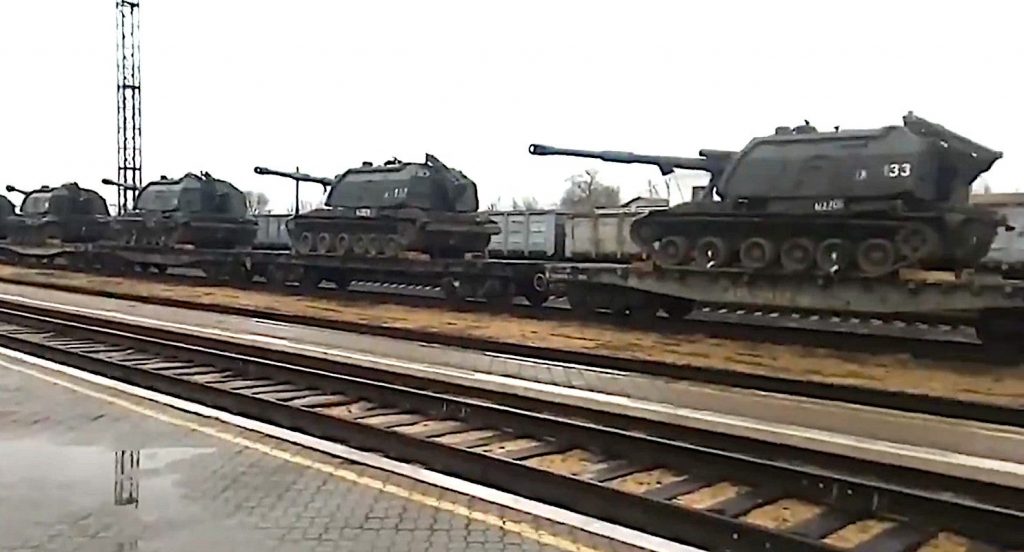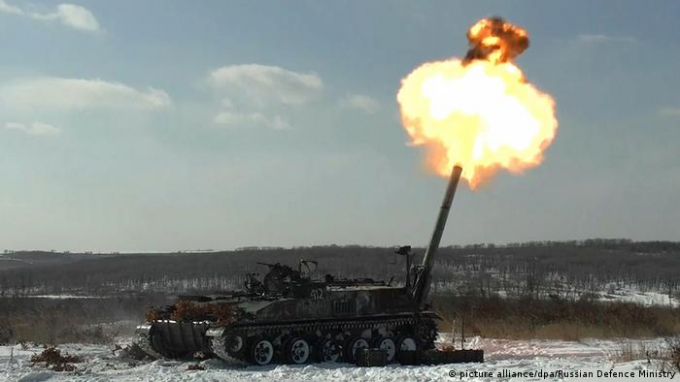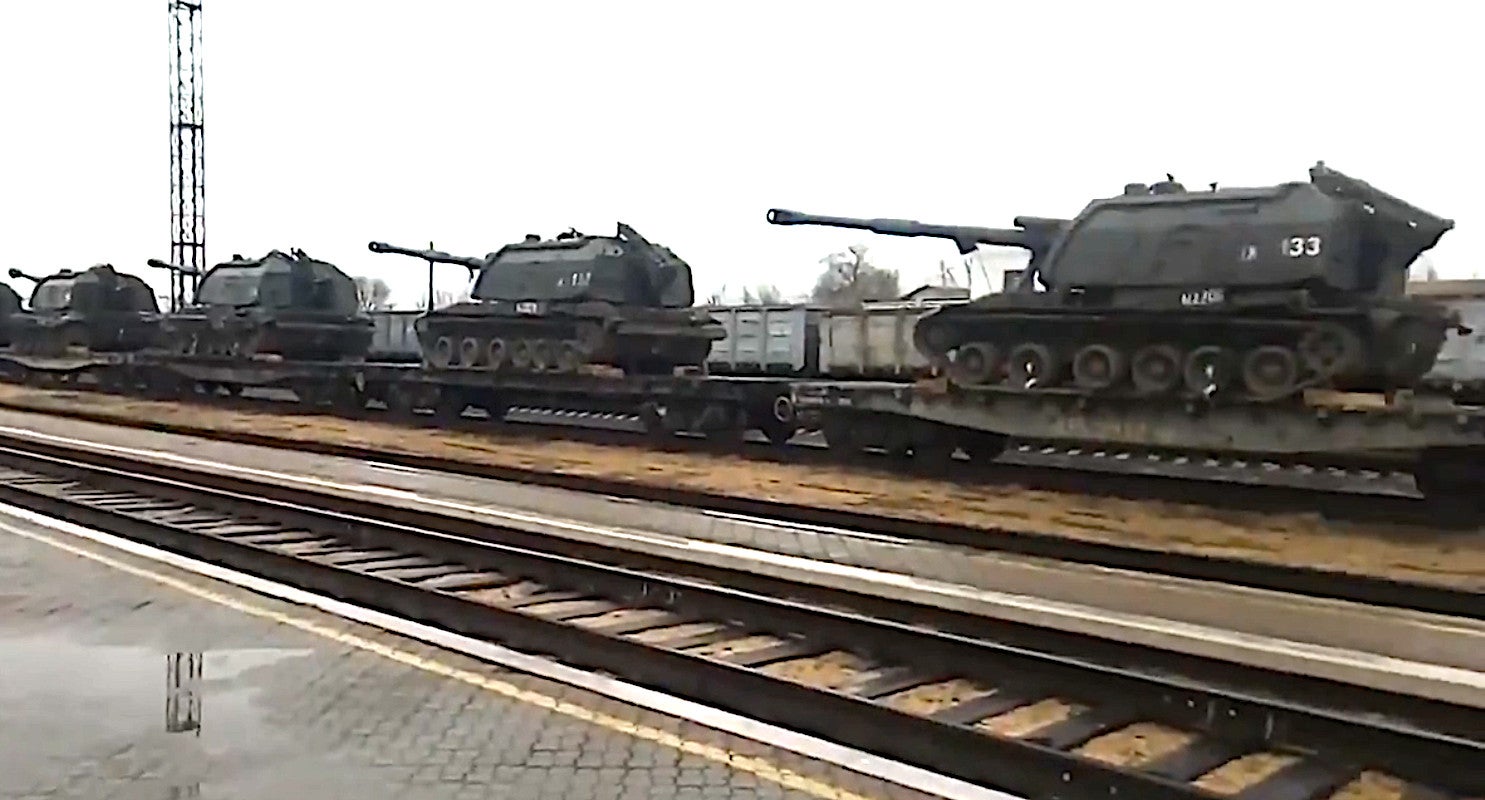On April 30, Army General Valery Gerasimov, the chief of the General Staff, said the exercises involved over 300,000 service members throughout Russia. He provided no detail on the numbers close to Ukraine but stressed the involvement of the 58th and 41st combined-arms armies (CAA) as well as the 7th, 76th and 98th Airborne Troops (Vozdushno-Desantnye Voyska—VDV) divisions. Gerasimov claimed that military personnel had returned to their bases, with the planned transportation of heavy equipment scheduled to finish by May 12 (Deutsche Welle—Russian service, May 7).
Reinforcements for the Black Sea Fleet: #ВМФ Project 775 Ropucha class LSTMs, tank carrying landing ships, #Cф NF Alexander Otrakovsky 031 & Cф NF Kondopoga 027 transited Bosphorus towards the Black Sea en route to Sevastopol pic.twitter.com/maoJSWH3GY
— Yörük Işık (@YorukIsik) April 17, 2021
According to the Commander of the Southern MD, Army General Aleksandr Dvornikov, the exercises that followed the snap inspection were large scale and involved the Aerospace Forces (Vozdushno-Kosmicheskie Sily—VKS), Ground Forces, the Black Sea Fleet and the Caspian Flotilla. These exercises included battalion tactical groups coordinating their actions with ship crews and squadrons of operational-tactical, naval and army aviation. Naval infantry rehearsed repelling amphibious and airborne assault forces. However, Dvornikov also highlighted these exercises as a response to what Moscow characterized as an increase in the North Atlantic Treaty Organization’s (NATO) naval activity close to Georgia and Ukraine (Interfax, March 21).
In southeastern Ukraine, the 1st and 2nd corps of the Russian-led separatists [collaborators - Ed.] headquartered in Donetsk and Luhansk, respectively, are subordinated to Russia’s 8th Combined-Arms Army in the Southern MD. The 8th CAA is spearheaded by the 150th Motorized Rifle Division, which acts as a reserve for the Russian-led separatist forces in Donbas (see EDM, March 11). During tactical exercises involving VDV units in Crimea (see EDM, May 3), more than 350 personnel rehearsed “capturing” an airfield of the hypothetical enemy and establishing a bridgehead for the insertion of the main forces. This exercise was joined by artillery units and focused on the Opuk military training ground in eastern Crimea. “In accordance with the concept of the exercise, the reinforced paratrooper battalion of the Guards Airborne Assault Caucasian Cossack Regiment, having flown with seven Il-76MD aircraft, landed on the Okhchi-Oba landing site in Crimea with the task of seizing an airfield held by illegal armed groups, thus, ensuring the landing of aircraft with the main forces of the regiment,” noted the commander of the Guards Airborne Assault Caucasian Cossack Regiment, Lieutenant Colonel Konstantin Zizevsky (Interfax, March 18).

The exercises also involved reinforcing the Black Sea Fleet with three large landing ships from the Baltic Fleet, the Minsk, Kaliningrad and Korolev, as well as the Boykiy corvette. These were reported to have passed through the Danish Straits on April 21—monitored closely by United Kingdom’s Royal Air Force P-8A Poseidon anti-submarine aircraft, scrambled from Lossiemouth airbase in Scotland—and later sailing the English Channel (Interfax, March 21).
Throughout the period of the snap inspections to test combat readiness within Russia’s Armed Forces, estimates of the numbers of Russian military personnel who were moved close to the border with Ukraine varied between 70,000 and 90,000 (Deutsche Welle—Russian service, April 19; Interfax, March 21). While the precise numbers are unclear, it is certain that the exercises testing combat readiness for large-scale warfare. Many have questioned Moscow’s drawing down of forces close to Ukraine’s borders—among them, Mykola Sungurovsky, the director of military programs at the Razumkov Kyiv Analytical Center. He described the April events as “not ordinary exercises, but an operation to raise readiness,” linking this with the situation inside Russia, as well as with the aggravation of relations between the Russian Federation and the West. Sungurovsky expressed confidence that Moscow will leave forces near the border with Ukraine in order to “keep Kyiv and the West in suspense” (Deutsche Welle—Russian service, May 7).
In military terms, the senior leadership of the Russian Armed Forces justified the exercises as a combat-readiness test, examining issues such as strategic mobility, command and control over large formations, and inter-service operations. Equally, the snap inspections have been linked to preparations for the annual strategic military exercise in September—this year, Zapad 2021, in the western strategic direction. Politically, of course, these movements of personnel and heavy equipment were cast as a “response” to NATO exercises close to Russia’s borders. Strong indications also exist that the exercises and force buildup were intended to coerce the government in Kyiv, either to make it more malleable to Moscow’s diplomatic efforts or to warn against any action to target the Russian-led collaborator forces in Donbas (Deutsche Welle—Russian service, April 19; Interfax, March 21).
Read More:
- Is Ukraine getting closer to NATO membership?
- New reservists law in Ukraine: A forced step forward
- Moscow speaking: the endless list of the Kremlin’s enemies
- Ukrainians fear Moscow may use their co-ethnics in Russia in provocation to restart war
- Role of airborne troops in Russia’s military buildup in occupied Crimea
- Putin failed to achieve his 3 goals in Ukraine because he’s not ready to launch a major war, Polish analyst says
- Threat of major Russian military operation against Ukraine and West hasn’t disappeared, Felgenhauer says
- Official data prove Russia funnelled trainloads of ammo and fuel to occupied Donbas in early 2015
Trending Now





